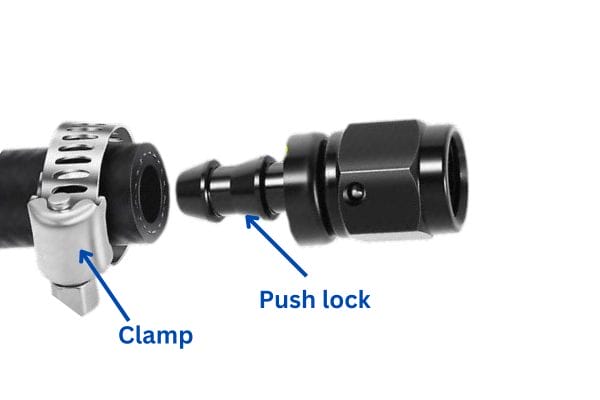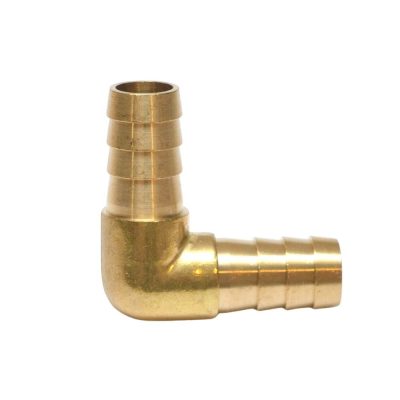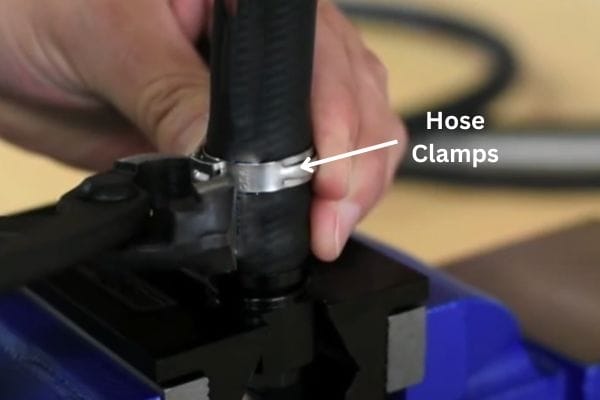Push-lock fittings are designed to ensure a secure, leak-free connection without the need for clamps or special tools, greatly simplifying the installation process. Push-lock couplings ensure the efficient operation of hydraulic fluid power systems. From automobiles to industrial machinery, their ease of use and ruggedness under high-pressure conditions make them indispensable in a wide range of industries. This article provides a comprehensive overview of push-lock fittings, detailing their various features and comparing them to other types of fittings.
Push-lock fittings are specialized connectors used to join hoses or tubes to various components in a fluid transfer system. These fittings are designed to form a safe and secure seal with the help of hose clamps without the need for additional fixtures or complicated installation tools. Typically, push-lock fittings come with a barb insert that hooks onto the hose internally to ensure a tight connection and withstand pressure and vibration. This design makes it ideal for a variety of industrial, automotive, agricultural and domestic applications.

Push-lock fittings consist of two main components that work together to ensure a secure, leak-proof connection:
Threaded End: This end of the fitting is designed to connect to a system port or another fitting, providing a secure threaded connection point. The threaded end ensures easy integration of the fitting into an existing system for a solid, reliable connection.
Hose End: This end features a barbed structure for inserting a hose. The barbs on the insert grip the inside of the hose, preventing the hose from slipping out and ensuring a tight seal. The barb design enhances the fitting’s grip on the hose and provides additional mechanical retention and security, especially when used with hose clamps.
Push locks offer several distinct advantages that make them a preferred choice for various applications:
Ease of Installation: Push-on fittings are straightforward to install, requiring no special tools beyond a hose clamp. The push lock design simplifies the installation process, making it quick and easy, which reduces downtime and labor costs.
Secure Connection: When combined with a hose clamp, push lock hose fittings provide a reliable, leak-proof seal. This ensures that the hose remains securely attached even under high pressure, vibration, or movement, maintaining the system’s efficiency and safety.
Versatility: These fittings are suitable for a wide range of applications and materials. They can be used with various types of hoses and tubing, making them a versatile solution for different fluid transfer needs across multiple industries.
Time-Saving: The quick installation process of push lock hose fittings significantly reduces downtime. This time-saving aspect is particularly beneficial in industrial and commercial applications where maintaining operational efficiency is crucial.
Push locks are utilized in a variety of applications across different sectors due to their reliability and ease of use:
Automotive Systems: Push locks are commonly used in automotive systems, such as fuel lines, coolant lines, and other fluid transfer applications in vehicles. Their ability to provide secure connections in these critical systems ensures optimal performance and safety.
Industrial Machinery: In industrial settings, push locks are employed in hydraulic lines, pneumatic systems, and other machinery that require reliable fluid connections. Their durability and ease of installation make them ideal for maintaining complex industrial systems.
Agricultural Equipment: Push locks are also used in agricultural equipment, including irrigation systems, sprayers, and other machinery. They help ensure the efficient transfer of fluids essential for agricultural operations.
Home and Garden Equipment: These fittings are found in various home and garden applications, such as lawnmowers, garden hoses, and other maintenance tools. Their versatility and reliability make them a practical choice for everyday use.
Push locks are manufactured from a variety of materials, each chosen for its specific properties that suit different application requirements:
Brass: Known for its durability and resistance to corrosion, brass is a common material for push lock hose fittings. It is suitable for a wide range of fluid transfer applications due to its robust performance in harsh environments.
Stainless Steel: Stainless steel offers high strength and excellent resistance to corrosion and temperature extremes. This makes it ideal for applications where durability and long-term performance are critical.
Carbon Steel: Carbon steel fittings provide strength and wear resistance, making them suitable for heavy-duty applications. They are often used in environments where the fittings are exposed to high pressures and mechanical stress.
High-Strength Polymers: Lightweight and resistant to many chemicals, high-strength polymers are suitable for less demanding applications or where weight is a concern. These materials provide a cost-effective and flexible solution for various fluid transfer needs.
Push lock fitting operates on a simple yet highly effective connection mechanism. The hose end of the fitting features a barbed insert that is designed to be pushed into the hose. The barbs on the insert grip the inner wall of the hose, creating friction that holds the hose securely in place. To enhance the connection’s security, a hose clamp is used to compress the hose around the barbed insert, further preventing any potential slippage and ensuring a tight seal.
Push locks are designed to withstand specific pressure ratings, which vary based on the material and size of the fitting. These ratings are critical to ensuring the fittings can handle the operational demands of the application without failing.
Material Influence: The material of the fitting, such as brass, stainless steel, or high-strength polymers, plays a significant role in determining its pressure rating. Metal fittings generally offer higher pressure ratings compared to polymer fittings.
Size Considerations: Larger fittings can typically handle higher pressures due to their increased surface area and structural integrity. Conversely, smaller fittings may have lower pressure ratings.
Application Requirements: It is essential to select fittings that meet or exceed the pressure requirements of the specific application. This ensures safety and optimal performance, preventing issues such as leaks, bursts, or fitting failure.

Several factors can influence the performance of push locks, affecting their reliability and longevity:
Hose Temperature: Temperature extremes can significantly impact the flexibility and sealing ability of the hose. High temperatures can cause the hose material to soften, potentially weakening the connection. Conversely, low temperatures can make the hose rigid, which may lead to cracks or leaks. It is crucial to select hoses and fittings that are rated for the temperature range of the application.
Hose Diameter: The inside diameter of the hose must match the fitting precisely to ensure a secure connection. A mismatch in diameter can lead to an improper fit, compromising the seal and increasing the risk of leaks. Ensuring that the hose and fitting diameters are compatible is vital for maintaining a reliable connection.
Hose Material: The material of the hose also affects the performance of push locks. Different materials have varying levels of flexibility, chemical resistance, and durability. Choosing the right hose material for the specific application ensures that the connection remains secure and performs well under the given conditions.
Environmental Conditions: The environment in which the fittings are used can also affect their performance. Exposure to harsh chemicals, UV light, or abrasive conditions can degrade the hose and fittings over time. Selecting materials that are resistant to these environmental factors can prolong the life of the fittings and maintain their performance.
Appearance:
Push Lock Fitting: Push lock fittings have a threaded end and a hose end with a barbed structure. The barbs on the hose end are designed to grip the inner wall of the hose. A hose clamp is typically used to secure the hose around the fitting.
Hose Barb Fitting: Hose barb fittings also feature a barbed end that is inserted into the hose. The barb design is similar, with multiple ridges that grip the hose internally. These fittings usually come with or without threads on the other end, depending on the connection requirements.
Sealing Mechanism:
Push Lock Fitting: The primary sealing mechanism for push lock fittings is the tight grip of the barbed insert on the hose, enhanced by the use of a hose clamp. This combination ensures a secure and leak-proof seal.
Hose Barb Fitting: Similar to push lock fitting, hose barb fittings rely on the barbed end gripping the hose’s inner wall. However, a hose clamp is also essential to provide the necessary compression and ensure a tight seal.

Appearance:
Push Lock Fitting: As previously described, push lock fittings have a barbed end for hose connection and a threaded end for system integration. The hose end requires a hose clamp to secure the connection.
Push to Connect Fitting: Push to connect fittings, also known as push-fit or quick-fit fittings, have a smooth, cylindrical appearance. They typically lack visible barbs and are designed for quick insertion and removal of tubing. These fittings often feature a collet (a gripping ring) inside the fitting to hold the tubing in place.
Sealing Mechanism:
Push Lock Fitting: Sealing is achieved through the barbed insert gripping the hose internally, with the hose clamp providing additional compression to ensure a secure seal.
Push to Connect Fitting: The sealing mechanism in push to connect fittings involves an internal O-ring that creates a tight seal when the tubing is pushed into the fitting. The collet grips the tubing to prevent it from slipping out, ensuring a reliable and leak-proof connection without the need for external clamps.
Appearance:
Push Lock Fitting: Push lock hose fittings are characterized by their threaded end and barbed hose end. The barbed end requires the use of a hose clamp to secure the hose.
Quick-Connect Fitting: Quick-connect fittings have a distinctive design that allows for rapid connection and disconnection. They often feature a locking mechanism, such as a sleeve or button, that secures the connection when the mating parts are pushed together.
Sealing Mechanism:
Push Lock Fitting: The sealing mechanism relies on the barbed structure gripping the hose and the hose clamp providing additional compression for a secure seal.
Quick-Connect Fittings: Quick-connect fittings use an internal O-ring to create a seal when the mating parts are connected. The locking mechanism ensures that the connection is maintained securely. This type of fitting eliminates the need for external clamps or tools, making it extremely convenient for applications requiring frequent connections and disconnections.
To ensure a smooth and successful installation of push lock hose fittings, gather the following tools and equipment:
Hose Cutter: For making clean and precise cuts on the hose or tubing.
Caliper or Measuring Tool: To measure the hose and fitting dimensions accurately.
Lubricant: (If recommended by the manufacturer) to ease the insertion process.
Cutting the Hose/Tubing:
Use a hose cutter to make a clean, straight cut at the end of the hose or tubing. A straight cut ensures a better seal and easier insertion.
Preparing the Fitting:
Ensure the push lock fitting is clean and free from any debris or contaminants. Check the barbed end to ensure it is smooth and undamaged.
Assembling the Fitting with the Hose/Tubing:
Push the hose over the barbed insert of the fitting. Apply steady pressure to slide the hose over the barbs until it reaches the base of the fitting. If recommended by the manufacturer, use a lubricant to ease this process.
Ensuring a Secure Connection:
Once the hose is fully seated on the barbed insert, place a hose clamp over the end of the hose where it overlaps the fitting. Tighten the clamp securely to compress the hose against the barbs, ensuring a tight, leak-proof seal.

Verify Hose and Fitting Size Compatibility: Ensure that the internal diameter of the hose matches the fitting size to prevent leaks and ensure a secure connection.
Ensure Clean Hose End: Before insertion, make sure the hose end is clean and free from any debris or contaminants that could affect the seal.
Use Lubricant if Recommended: If the manufacturer recommends using a lubricant, apply it sparingly to the barbed insert to make the insertion process smoother and reduce the risk of damaging the hose.
Using an Incorrect Hose Size: Ensure the hose size matches the fitting size exactly. A mismatch can lead to poor sealing and potential leaks.
Not Pushing the Hose Fully onto the Fitting: Ensure the hose is pushed all the way onto the barbed insert until it reaches the base of the fitting. Incomplete insertion can compromise the connection’s integrity.
Skipping the Use of Lubricant When Necessary: If a lubricant is recommended, not using it can make the insertion process difficult and increase the risk of damaging the hose or fitting.
Selecting the right push lock fitting involves assessing various factors to ensure they meet the specific needs of your application. Here are some key considerations:
Pressure Ratings: The fittings must be able to withstand the maximum pressure of your system. It’s essential to check the pressure rating specified by the manufacturer and ensure it aligns with your system’s requirements. Using fittings with insufficient pressure ratings can lead to failures and safety hazards.
Temperature Range: Different materials can handle different temperature ranges. Ensure that the push locks you select can operate effectively within the temperature conditions of your application. If your system operates in extreme temperatures, both high and low, choosing the appropriate material (such as stainless steel for high temperatures or certain polymers for lower temperatures) is crucial for maintaining performance and safety.
Ensuring compatibility with the existing system components is vital for a seamless and efficient installation. Here are the key aspects to consider:
Material Compatibility: The fittings should be compatible with the hoses, tubes, and other components in your system. For instance, if your system uses hoses made of a particular material, the push locks should be compatible with that material to prevent chemical reactions, corrosion, or other issues that could compromise the integrity of the connection.
Size Matching: The internal diameter of the hoses or tubing must match the size of the push locks to ensure a secure and leak-proof connection. Mismatched sizes can lead to poor sealing and potential system failures. Accurate measurements and verification of sizes are critical during the selection process.
System Requirements: Consider any specific requirements or constraints of your system, such as space limitations, fluid types, and environmental conditions. Select fittings that meet these specific needs to ensure optimal performance.
Push lock fittings are indispensable in hydraulic and pneumatic systems due to their easy installation, secure connections, and versatility. Their capability to provide reliable, leak-proof seals makes them a preferred choice across various industries. Given their numerous advantages and wide range of applications, push lock fittings are a valuable addition to any fluid transfer system, ensuring efficiency and reliability.
Push locks are used to connect hoses or tubing to various components in fluid transfer systems, such as hydraulic and pneumatic systems. They are commonly found in automotive, industrial, agricultural, and home applications.
Push lock fitting has a barbed insert that grips the inner wall of the hose. A hose clamp is used to compress the hose around the barbed insert, ensuring a tight and leak-proof seal.
Push locks are typically made from materials like brass, stainless steel, carbon steel, and high-strength polymers. The choice of material depends on the application requirements, such as pressure, temperature, and chemical compatibility.
When selecting push locks, consider factors like pressure ratings, temperature range, compatibility with existing system materials and components, and the specific requirements of your application.
To install push locks, you need a hose cutter for making clean cuts, a caliper or measuring tool for accurate measurements, and a lubricant (if recommended by the manufacturer) to ease the insertion process.
Avoid using an incorrect hose size, not pushing the hose fully onto the fitting, and skipping the use of lubricant when necessary. Ensuring a clean, debris-free hose end and properly securing the hose with a clamp are also crucial for a successful installation.